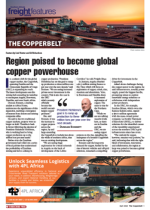Consensus amongst global analysts and producers of copper is that the price is set to continue climbing.Copper and gold were the only two metals to rise in price during 2023.BMI, a Fitch Solutions research unit, has forecast a price increase of up to 75% over the next two years.Early in April, Citi analysts predicted that copper prices would average $10 000 a metric ton by the end of the year, climbing to $12 000 in 2026. “Explosive price upside is possible over the next two to three years, if a strong cyclical recovery occurs at any time, with prices potentially rising more than two thirds to $15k/t+ in this, our bull case scenario,” Citi analysts said in a research note.The biggest importers of copper are China, Japan, India, South Korea and Germany, all of which are transitioning to renewable energy and electric vehicles – two of the main drivers of physical demand for the metal. With a conductivity rating second only to silver, copper is the natural choice for use in energy storage, electric vehicles (EVs) and EV charging infrastructure.Energy transition technologies are expected to account for nearly half the growth in demand for copper, which is the third most widely used metal in the world after iron and aluminium, according to the US Geological Sur vey. There has been a spike in the copper price following the imposition in April of sanctions against Russian copper by the United States and United Kingdom to reduce funding for Russia’s invasion of Ukraine.According to GlobalData, Russia accounts for around 3% of global production.Chile accounts for over one-third of the world's copper production followed by Peru, Democratic Republic of the Congo, China, United States, Australia, Indonesia, Zambia, Canada, and Poland. Zambia supplies about 4% of global consumption and the DRC 11%, according to Nasdaq analysts. They put Russian production ahead of Zambia’s.There is potential for further growth in the Copperbelt, which is the largest and most prolific mineralised sediment-hosted copper region in the world, according to Geology for Investors.Covering Zambia, the Democratic Republic of Congo and southeastern Angola, the area has been mined for over 100 years. Reserves are estimated at over five billion tons of copper ore with grades up to 4%. The Copperbelt also contains around 40% of the world’s cobalt.This is attracting ongoing global investment in the region from both Western and Chinese companies.

